VMware: Parallel port problems on Windows 9x/Me.
On Windows operating systems, you can use Device Manager to view information about your hardware, the drivers that are used to access the different devices, the resources a given device uses. You can also see in Device Manager when a device is not working. As well as you can use this feature to add, remove, enable or disable a device.
If you are running Windows 95, Windows 98, or Windows Me as a VMware guest, you'll find several devices that are marked with a yellow background exclamation mark (sometimes the device icon being replaced by a yellow question mark, meaning that Windows does not know this device), indicating that there is some issue with this device. The screenshot below shows Device Manager on my Windows Me VMware virtual machine. Beside the USB devices (there isn't any USB2 driver for Windows Me; at least I didn't find one), the device Printer port (LPT1) is shown with an exclamation mark.
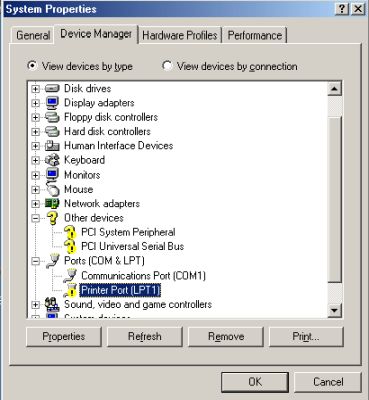 |
Parallel port problems on Windows 95/98.
If in Device Manager you right-click the Printer port (LPT1) to view its Properties, you can see in the General tab (screenshot on the left, taken on my Windows 98, German language version), that Windows is not able to use the device, its status reporting an error code 24, the device being said not to exist, not to function correctly or that some drivers would be missing. Looking at the Driver tab (screenshot on the right), you can see that there is a Microsoft driver installed.
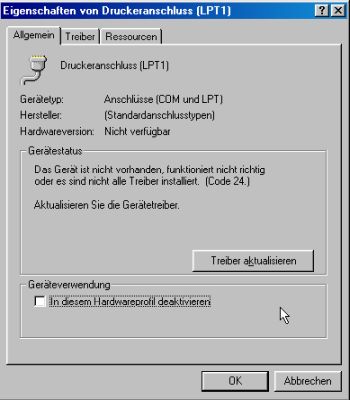 |
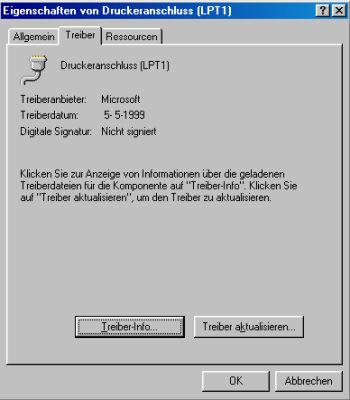 |
As parallel ports are devices existing up from the beginning of the PC era, it may be assumed that this default driver should work and that the issue is to be searched for elsewhere. If you have a look at the Resources tab of the device properties, you (probably; cf. below) will discover the reason why the Printer port (LPT1) device can't work: the (default) interrupt 07 is used by another device.
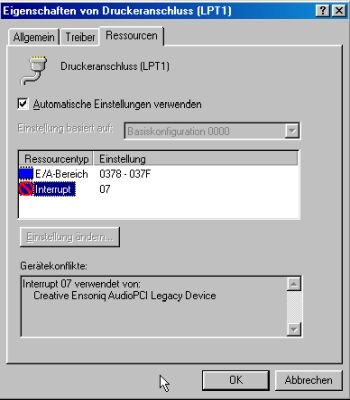 |
Unselecting the Use automatic settings checkbox gives you the possibility to try other resource configurations for the port. But, there is nothing you can do this way: All possible interrupts are already used!
So, the only possibility we have is to free an interrupt, what means that we'll have to disable some other device. If we have a closer look at the last screenshot, we can see that interrupt 07 is used by Creative Ensoniq AudioPCI Legacy Device. This is part of the audio driver software that has to be installed on a Windows 95/98 VMware virtual machine to get sound working (that means that if you haven't installed this software, you will not have to deal with the interrupt 07 issue). It seems that we have to decide if we want to have sound, or be able to use the parallel port. However, there is a really simple solution, allowing us to have both: The Creative Ensoniq AudioPCI Legacy Device is a secondary part of the Ensoniq driver system and it is not mandatory to have sound on our Windows 9x machine (it's Creative Ensoniq AudioPCI that gives sound to the machine). Thus, we can make available interrupt 07 by disabling the Creative Ensoniq AudioPCI Legacy Device in Device Manager.
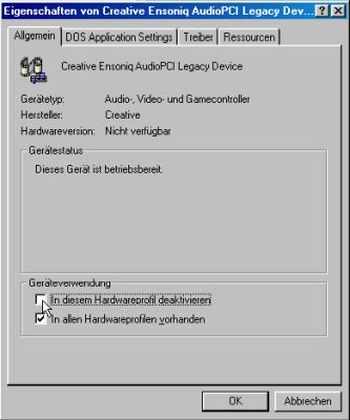 |
I had some problems when rebooting after having done these changes, but this may be specific to my system or even a more or less random event. Anyway, if one of these old Windows releases hangs, just push CTRL+ALT+DEL. As a difference with the latest versions of Windows this normally doesn't harm the system.
Why disabling the device and not uninstalling it? If you remove a device, the next time you start Windows, it will find a not yet registered device (with a "found new hardware" window popping up) and the device will be reinstalled. What would mean that we would be where we were at the beginning with interrupt 07 unavailable for the parallel port. On the other side, if we disable the device, it stays within the hardware profile, but isn't used; and the LPT1 device can use the interrupt.
Bad surprise however when taking a look at Device Manager: Despite the fact that the interrupt conflict has been resolved, the Printer port (LPT1) device is marked with an exclamation mark, meaning that the LPT port is still not working correctly!
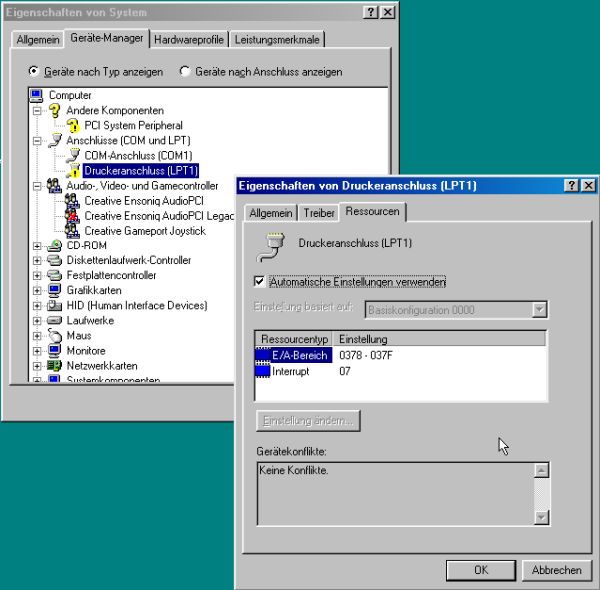 |
This seems to be a VMware problem (possibly the same with other virtualization software) on Windows 10 (possibly also on other Windows and Linux platforms): The physical LPT ports on the host don't work correctly on Windows 8x guests. And this independently of how you configure the parallel port in the VM's BIOS. No idea why. No idea if there is a way to make them work. Thus, the only way to use parallel ports on a Windows 95 or a Windows 98 VMware virtual machine is to emulate them by a text file on the host.
Parallel port problems on Windows Me.
Windows Me supports the VMware SoundBlaster 16 audio card without the necessity to install some special drivers. The interrupt 07 issue, caused by the installation of the Ensoniq audio software, is thus not accurate on Windows Me. That does not mean, however, that the parallel port works correctly. In fact (as shows the first screenshot of this tutorial) Windows Me is not capable to use the Printer port (LPT1). The problem is the same as on Windows 9x: Independently of the virtual machine's BIOS settings, the physical LPT ports on the host don't work correctly on Windows Me guests (at least on a Windows 10 host). Thus, the only way to use parallel ports on Windows Me VMware virtual machine is to emulate them by a text file on the host.
Parallel ports on Windows NT4/2000/XP.
There is no problem to emulate the parallel port on a Windows 2000 or Windows XP VMware virtual machine by using a Windows 10 physical LPT port. On Windows NT4, the situation may be different. NT has no device manager, so it's more difficult to see which hardware works and which doesn't. On my VM, parallel port related software is running. Opening the Ports item in Control Panel, I only see the serial port listed. But this seems to be for COM ports only. Thus, no idea if the physical LPT ports on the host work correctly on Windows NT guests...
If you find this text helpful, please, support me and this website by signing my guestbook.